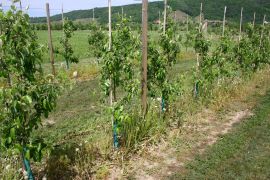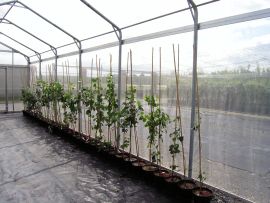


Mycorrhizal symbioses of transgenic apple trees with increased fungal resistance
The project is funded by BMBF within the framework
"Transgenic woody plant species"


Wild-type (above) and transgenic (below) apple trees (cv Pinova)
Contact:
Tina Schäfer
tina.schaefer@ufz.de
phone: ++49-(0)345-5585-224
fax: ++49-(0)345-5585-449
Prof. François Buscot
francois.buscot@ufz.de
phone: ++49-(0)345-5585-221
fax: ++49-(0)345-5585-449
Theodor-Lieser-Straße 4
06120 Halle/Saale
This project deals with genetically modified apple trees that express two fungal chitinase genes conferring increased resistance against fungal pathogens. Here, it is investigated whether they have altered mycorrhization rates in comparison to wild-type strains. The chitinases used for transformation are enzymes that attack the main component of fungal cell walls, especially that of Venturia inaequalis, the causal agent of apple scab and Podosphaera leucotricha, the causal agent of powdery mildew. For pomiculture, grafting of transgenic scions onto wild-type rootstocks is planned. It is hoped that the transgenic part confers resistance against apple scab and powdery mildew whereas the wild-type rootstock determines the growth pattern of the mature tree.
The roots of apple trees can support two very different types of mycorrhiza: arbuscular mycorrhizal fungi belong to the kingdom Glomeromycota and transport water and mainly phosphate to the plant. On the other hand, ecotmycorrhizal fungi are either Asco- or Basidiomycota providing the plant with water and mainly nitrogen. Thus, both types of mycorrhiza are important for adaptation of trees to local conditions, but, being fungi, are potentially threatened by the expression of enzymes that attack fungi!
Since information on the mycorrhizal flora of apple trees is lacking, a first step is the identification of mycorrhizal fungi in the roots of wild-type trees in orchards under different management. This information is important since due to GMO regulations, the transgenic trees can so far only be cultivated in greenhouses and it is known that this could alter the mycorrhizal flora. In another step, mycorrhization of several transgenic tree lines grown in the greenhouse (but in soil from orchards) is monitored using morphological and molecular tools.
